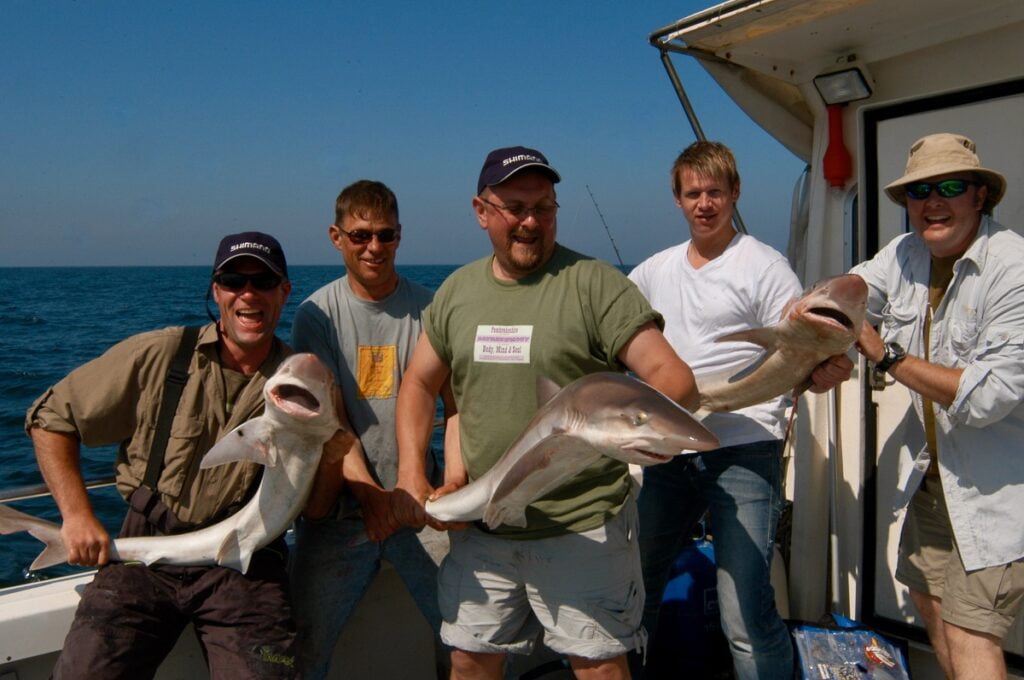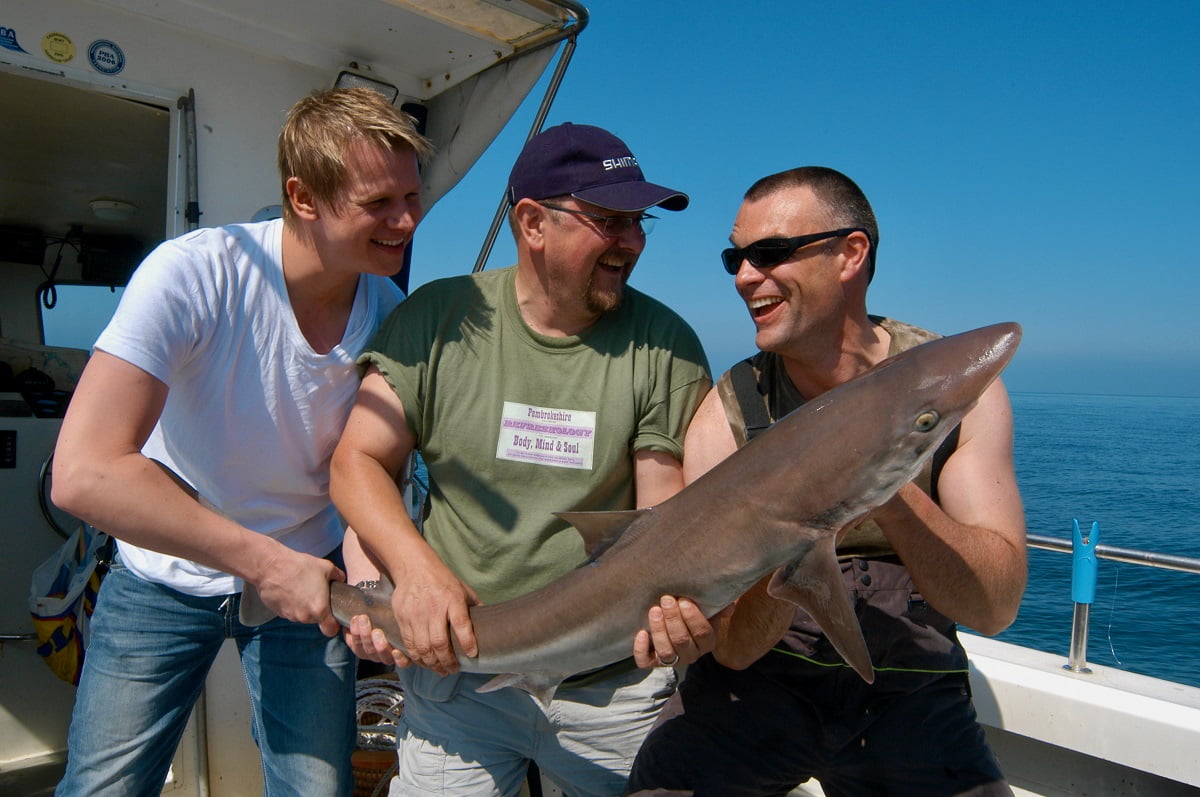Tope Fishing In Wales
In this article about Welsh tope fishing, Dave Lewis shares his insights into this most sporting sea fish, a hard fighter that is found in abundance around our coastlines.
Throughout the 1960s and 70s south-west Wales used to be regarded as one of the most prolific areas for catching tope, anywhere in the UK. Carmarthen Bay was the epicenter of this tremendous fishery, and it was here while fishing 2 miles off the south-east corner of Caldey Island in 1964 that Albert ‘Ack’ Harries’ caught what at the time was a world record tope weighing 74lb lloz. His son caught a 72-pounder around the same time.
Neither of these were fluke catches. Ack’s record fish was the culmination of years of specialist tope fishing, combined with an intimate knowledge of the prolific ground off his home port of Saundersfoot. Today the tope fishing throughout the same area remains hugely productive, in no small part due to the fact that it is illegal to target tope commercially in UK waters. Today combined boat catches numbering in the dozens are commonplace in here Wales, when the fish are running.
Tope, Galeorhinus galeus, are a species of hound shark that are typically found in coastal waters. A highly migratory species, tope that have been tagged in the UK having been recaptured in The Azores, the Canary Islands and even off the coast of Iceland.

Tope are one of the hardest fighting fish anglers can target off the coast of the British Isles. Depending on location the average size of tope caught in Wales is probably between 10-30lb, but many much larger specimens are regularly caught. This is especially so during the spring, when heavily pregnant females move inshore to drop their pups. At such times it is possible to catch fish over 60lb. The current official British boat caught record for tope stands at 82lb 8oz, with a fish caught of Bradwell-on-Sea in Essex in 1991, but there is little doubt larger fish have been caught and returned by anglers fishing in Welsh waters. At certain parts of the coast off Pembrokeshire and north-west Wales it is also possible to catch tope from the shore.
Tope are widely distributed off almost the entire coastline of Wales, with the vast majority being caught from inshore reefs and banks, or within the vicinity of large tidal estuaries. Fish are occasionally found in deeper water over relatively featureless ground.

In the Bristol Channel large numbers of fish can be found starting from around from The Nash Sand Bank off the Glamorgan coast, all the way west to Carmarthen Bay, notably off the Gower Coast.
Pembrokeshire is one of the best places in the UK to catch from the shore, and offshore good numbers of fish can be encountered from Caldey Island all the way around this rugged and spectacularly beautiful coastline to Cardigan Bay.
Continuing north, the various shallow reefs found within Cardigan Bay such as Sarn Badrig, offer truly incredible fishing. Plenty of fish are caught all around the Llyn Peninsula, off Anglesey, and along the coast of North Wales as far as the Dee Estuary.

Typically the best tackle to use when targeting tope will be dictated by the area you are fishing. In shallow water uptiding is almost always the most effective technique, as it ensures baits fish well away from the scare area created by a boat anchored in shallow water.
In deeper water traditional boat fishing outfits are perfect, with a 20-30lb class rig probably being the best all round outfit for tope. Some anglers use very light tackle such as carp rods when fishing for tope. This is not ideal, as invariably it results in unnecessarily prolonged fight times which subject the fish to undue stress.
Ack Harries used an 18ft wire trace to catch his record tope, which was the norm back in the 60s. These days most anglers use either a short 6-8in length of wire, connected to heavier monofilament to create a 4-6ft hook length. Or better still a similar length of 200lb monofilament straight through to the hook, without any wire which helps minimise damage to fish. You’ll also need to use a rubbing leader of around 12-20ft of 50lbBS monofilament. This guards against breakages caused by abrasion with the topes rough skin, should the fish roll up the line during the fight.
Ack Harris used a 10/0 hook, but a single J hook in size 6/0 to 8/0 is perfect, ideally with the barb crushed. Bronze hooks are preferable. Some fish invariably swallow a bait and the safest way to release these with minimum harm, is to cut the trace as close to the fishes mouth as possible. Unlike stainless steel or zinc coated hooks, bronze hooks will eventually corrode and fall out. An increasing number of anglers are using circle hooks for tope, as these invariably locate neatly into the corner of the fishes jaw.
Tope are a highly predatory species so fish baits are usually the most effective. Freshly caught mackerel take a lot of beating, especially when prepared as a flapper with the back bone removed. If mackerel are not available other species such as whiting, pouting, herring, launce, garfish, small pollack and coalfish, scad and even various species of flatfish can all be used with great effect. Frozen baits are effective, too.

Like all species of shark tope have a highly developed sense of smell and can locate baits from a great distance. Occasionally when tope fishing you start catching fish immediately, but more often than not it takes a while for fish to locate baits from the scent trail they emit. Using bags of chum or chunking with small pieces of bait as when shark fishing, can be highly effective at attracting fish. Patience is often the key to successful tope fishing. If tope are in the area then there is little doubt that given time they will eventually locate your baits, and from that point onwards sport can be fast and furious.
Old writings on tope fishing used to recommend letting tope run with a bait, wait for it to stop, and only attempting to set the hook when the fish moves off on its second run. Follow this advice and almost always the result will be a gut hooked fish. My advice, unless using circle hooks, would be to set the hook as soon as possible after the run begins, which more often than not will result in the fish being hooked in the jaw. If you miss the fish immediately put the reel back into free spool and wait. If there is any bait left on the hook almost always the same fish, or another one, will pick up the bait again.

Charter boats are located at ports all around the Welsh coastline, and between April and October these will be able to take you tope fishing. Make contact with the skipper of a boat in the area you would like to fish as soon as possible. They will be able to recommend the optimum time of year to fish, and a suitable tide. The marks where tope are caught from the shore and not well documented, but enquiries at local tackle shops will certainly point you in the right direction, good luck!

The three anglers in these images are actors Julien Lewis Jones, Charlie Dale and Danny Seaward, enjoying a glorious and fish filled day off the Gwynedd coast, with the mountains of Snowdonia proving a spectacular backdrop!
Words & Images: Dave Lewis

EPIC Welsh Fishing Lakes & Reservoirs from the Sky VIDEO
This cinematic drone montage showcases some of the most epic fishing lakes and reservoirs across Wales, from vast open waters…
Read More
Take a Friend Fishing is Back! Take someone you know fishing for FREE this Christmas and New Year
Calling all Anglers – Take someone you know fishing for FREE between Saturday 20th December 2025 and Sunday 4th of…
Read More
Tuna Sport Fishing Wales
Dave Lewis reports on the emergence of a rod and line tuna fishery off Welsh coasts; a huge draw for…
Read More



